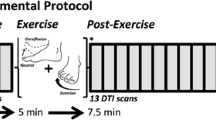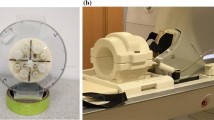Abstract
Purpose
To assess the transverse relaxation time T2 and diffusion coefficient D before and following exercise in the tibialis anterior muscle and determine whether T2 and D values were correlated.
Methods
Measurements of T2 and D were performed at 3 T within axial slices through the calf muscles of six healthy volunteers at 95 s intervals before and for 10–12 min after a dorsiflexion exercise to exhaustion.
Results
The mean ± standard deviation (SD) of T2 and D before exercise were 32 ± 1.55 ms and 1.52 ± 0.15 μm2/ms, and after exercise were 43 ± 2.5 ms and 1.72 ± 0.13 μm2/ms, respectively. The mean ± SD inter-individual recovery times of the % change in T2 and D after exercise were 7.9 ± 4.2 and 10.9 ± 7.0 min, respectively. The T2 and D values showed a significant correlation throughout the experiments (r 2 = 0.45).
Conclusions
The increase in T2 of skeletal muscle after exercise is correlated with the increase of the diffusion coefficient D and the recovery times appear similar, indicating that any model used to explain T2 increases with exercise must also account for increased diffusion coefficients.
Similar content being viewed by others
References
Fleckenstein JL, Canby RC, Parkey RW, Peshock DE (1988) Acute effects of exercise on MR imaging of skeletal muscle in normal volunteers. Am J Roentgenol 151: 231–237
Ploutz-Snyder LL, Nyren S, Cooper TG, Potchen EJ, Meyer RA (1997) Different effects of exercise and edema on T2 relaxation in skeletal muscle. Magn Reson Med 37: 676–682
Fisher MJ, Meyer RA, Adams GR, Foley JM, Potchen EJ (1990) Direct relationship between proton T2 and exercise intensity in skeletal muscle MR images. Invest Radiol 25: 480–485
Yue G, Alexander AL, Laidlaw DH, Gmitro AF, Ungar EC, Enoka RM (1994) Sensitivity of muscle proton spin–spin relaxation time as an index of muscle activation. J Appl Physiol 77: 84–92
Saab G, Thompson RT, Marsh GD (2000) Effect of exercise on muscle transverse relaxation determined by MR imaging and in vivo relaxometry. J Appl Physiol 88: 226–233
Cagnie B, Dickx N, Peeters I, Tuvtens J, Achten E, Cambier D, Danneels L (2008) The use of functional MRI to evaluate cervical flexor activity during different cervical flexion exercises. J Appl Physiol 104: 230–235
Kubota J, Ono T, Araki M, Torii S, Okuwaki T, Fukubayashi T (2007) Non-uniform changes in magnetic resonance measurements of semitendinosus muscle following intensive eccentric exercise. Eur J Appl Phsyiol 101: 713–720
Serrao FV, Serrao PRMD, Foerster B, Tannus A, Pedro VM, Salvini TF (2007) Assessment of the quadriceps femoris muscle in women after injury induced by maximal eccentric isokinetic exercise with low angular speed. J Sports Sci Med 6: 106–116
Larsen RG, Ringgaard S, Overgaard K (2007) Localization and quantification of muscle damage by magnetic resonance imaging following step exercise in young women. Scan J Med Sci Sports 17: 76–83
Morvan D, Leroy-Willig A (1995) Simultaneous measurements of diffusion and transverse relaxation in exercising skeletal muscle. Magn Reson Imaging 13: 943–948
Morvan D (1995) In vivo measurement of diffusion and pseudo-diffusion in skeletal muscle at rest and after exercise. Magn Reson Imaging 13: 193–199
Ababneh Z, Beloeil H, Berde C, Gambarota G, Maier SE, Mulkern RV (2005) Biexponential parametrization of T2 and diffusion decay curves in a rat muscle edema model: Decay curve components and water compartments. Magn Reson Med 54: 524–531
Hardy PA, Yue G (1997) Measurement of magnetic resonance T2 for physiological experiments. J Appl Physiol 83: 904–911
Damon BM, Gregory CD, Hall KL, Stark HJ, Gulani V, Dawson MJ (2002) Intracellular acidification and volume increases explain R2 decreases in exercising muscle. Magn Reson Med 47: 14–23
Damon BM, Hornberger JL, Wadington MC, Lansdown DA, Kent-Braun JA (2007) Dual gradient-echo MRI of post-contraction changes in skeletal muscle blood volume and oxygenation. Magn Reson Med 57: 670–679
Damon BM, Wadington MC, Hornberger JL, Lansdown DA (2007) Absolute and relative contributions of BOLD effects to the muscle functional MRI signal intensity time course: Effect of exercise intensity. Magn Reson Med 58: 335–345
Le Rumeur EC, De Certaines J, Toulouse P, Rochcongan P (1987) Water phases in rat striated muscles as determined by T2 proton NMR relaxation times. Magn Reson Imaging 5: 267–272
Fung BM, Puon PS (1981) Nuclear magnetic resonance transverse relaxation in muscle water. Biophys J 33: 27–38
Hazlewood CF, Chang DC, Nichols BK, Woessner DE (1974) Nuclear magnetic resonance transverse relaxation times of water protons in skeletal muscle. Biophys J 14: 583–606
English AE, Joy MLG, Henkelman RM (1991) Pulsed NMR relaxometry of striated muscle fibers. Magn Reson Med 21: 264–281
Cole WC, LeBlanc AD, Jhingran SG (1993) The origin of biexponential T2 relaxation in muscle water. Magn Reson Med 28: 19–24
Belton PS, Jackson RR, Packer KJ (1972) Pulsed NMR studies of water in striated muscle. I. Transverse nuclear spin relaxation times and freezing effects. Biochim Biophys Acta 286: 16–25
Peemoeller H, Pintar MM (1979) Nuclear magnetic resonance multiwindow analysis of proton local fields and magnetization distribution in natural and deuterated mouse muscle. Biophys J 28: 339–356
Meiboom S, Gill D (1958) Modified spin-echo method for measuring nuclear relaxation times. Rev Sci Instrum 29: 688–691
Mulkern RV, Wong STS, Jakab P, Bleier AR, Sandor T, Jolesz FA (1990) CPMG imaging sequences for high field in vivo transverse relaxation studies. Magn Reson Med 16: 67–79
Mitsouras D, Mulkern RV, Rybicki FJ (2006) Strategies for inner volume 3D fast spin echo magnetic resonance imaging using nonselective refocusing radio frequency pulses. Med Phys 33: 173–186
Gudbjartsson H, Maier SE, Mulkern RV, Morocz IA, Patz S, Jolesz FA (1996) Line scan diffusion imaging. Magn Reson Med 36: 509–518
Majumdar S, Orphanoudakis SC, Gmitro AI, O’Donnell M, Gore JC (1986) Errors in the measurement of T2 using multiple-echo MRI techniques. I. Effects of radiofrequency pulse imperfections. Magn Reson Med 3: 562–574
Poon C, Henkelman RM (1992) T2 quantification for clinical applications. J Magn Reson Imag 2: 541–553
Hennig J, Scheffler K (2000) Easy improvement of signal-to-noise in RARE-sequences with low refocusing flip angles. Rapid acquisition with relaxation enhancement. Magn Reson Med 44: 983–985
McDannold N, Szot Barnes A, Rybicki FJ, Oshio K, Chen NK, Hynynen K, Mulkern RV (2007) Temperature mapping consideration in breast with line scan echo planar spectroscopic imaging. Magn Reson Med 58: 1117–1123
Deux JF, Malzy P, Paragios N, Bassez G, Luciani A, Zerbib P, Roudot-Thoraval F, Vignaud A, Kobeiter (2008) Assessment of calf muscle contraction by diffusion tensor imaging. Eur Radiol. doi:10.1007/s00330-008-1012-z
Author information
Authors and Affiliations
Corresponding author
Rights and permissions
About this article
Cite this article
Ababneh, Z.Q., Ababneh, R., Maier, S.E. et al. On the correlation between T2 and tissue diffusion coefficients in exercised muscle: quantitative measurements at 3T within the tibialis anterior. Magn Reson Mater Phy 21, 273–278 (2008). https://doi.org/10.1007/s10334-008-0120-8
Received:
Revised:
Accepted:
Published:
Issue Date:
DOI: https://doi.org/10.1007/s10334-008-0120-8




